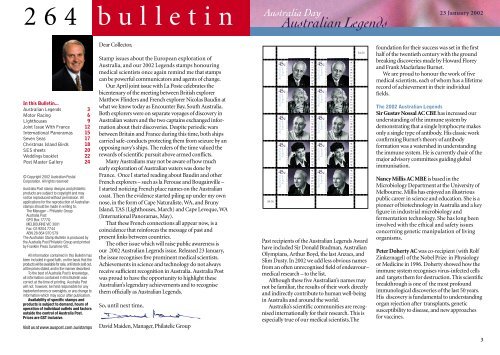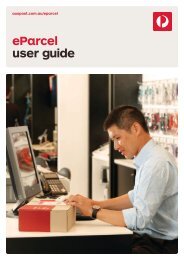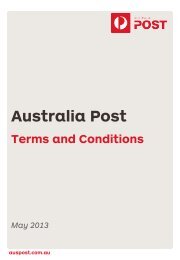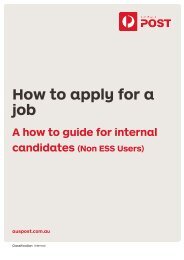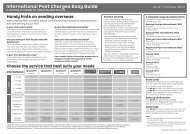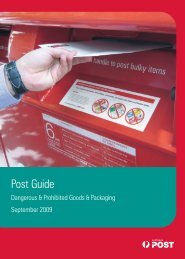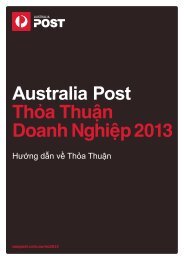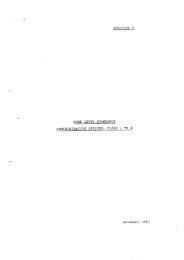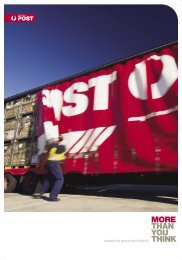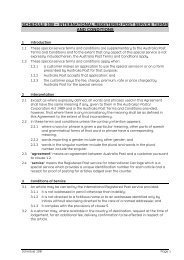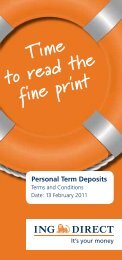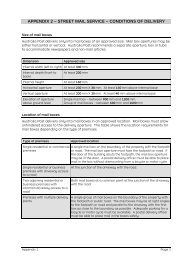Download - Australia Post Shop
Download - Australia Post Shop
Download - Australia Post Shop
You also want an ePaper? Increase the reach of your titles
YUMPU automatically turns print PDFs into web optimized ePapers that Google loves.
264 bulletin<br />
In this Bulletin...<br />
<strong>Australia</strong>n Legends 3<br />
Motor Racing 6<br />
Lighthouses 9<br />
Joint Issue With France 12<br />
International Panoramas 15<br />
Seven Seas 17<br />
Christmas Island Birds 18<br />
SES sheets 20<br />
Weddings booklet 22<br />
<strong>Post</strong> Master Gallery 24<br />
© Copyright 2002 <strong>Australia</strong>n <strong>Post</strong>al<br />
Corporation. All rights reserved<br />
<strong>Australia</strong> <strong>Post</strong> stamp designs and philatelic<br />
products are subject to copyright and may<br />
not be reproduced without permission. All<br />
applications for the reproduction of <strong>Australia</strong>n<br />
stamps should be made in writing to:<br />
The Manager – Philatelic Group<br />
<strong>Australia</strong> <strong>Post</strong><br />
GPO Box 1777Q<br />
MELBOURNE VIC 3001<br />
Fax: 03 9204 7744<br />
ABN 28 864 970 579<br />
The <strong>Australia</strong>n Stamp Bulletin is produced by<br />
the <strong>Australia</strong> <strong>Post</strong> Philatelic Group and printed<br />
by Franklin Press Sunshine VIC.<br />
All information contained in this Bulletin has<br />
been included in good faith, on the basis that the<br />
products will be available for sale, until stock sold out,<br />
at the prices stated, and in the manner described.<br />
To the best of <strong>Australia</strong> <strong>Post</strong>’s knowledge,<br />
all information contained in this Bulletin was<br />
correct at the time of printing. <strong>Australia</strong> <strong>Post</strong><br />
will not, however, be held responsible for any<br />
inadvertent errors or oversights, or any change to<br />
information which may occur after publication.<br />
Availability of specific stamps and<br />
products is subject to demand, hours of<br />
operation of individual outlets and factors<br />
outside the control of <strong>Australia</strong> <strong>Post</strong>.<br />
Prices are GST inclusive.<br />
Visit us at www.auspost.com.au/stamps<br />
Dear Collector,<br />
Stamp issues about the European exploration of<br />
<strong>Australia</strong>, and our 2002 Legends stamps honouring<br />
medical scientists once again remind me that stamps<br />
can be powerful communicators and agents of change.<br />
Our April joint issue with La <strong>Post</strong>e celebrates the<br />
bicentenary of the meeting between British explorer<br />
Matthew Flinders and French explorer Nicolas Baudin at<br />
what we know today as Encounter Bay, South <strong>Australia</strong>.<br />
Both explorers were on separate voyages of discovery in<br />
<strong>Australia</strong>n waters and the two captains exchanged information<br />
about their discoveries. Despite periodic wars<br />
between Britain and France during this time, both ships<br />
carried safe-conducts protecting them from seizure by an<br />
opposing navy’s ships. The rulers of the time valued the<br />
rewards of scientific pursuit above armed conflicts.<br />
Many <strong>Australia</strong>ns may not be aware of how much<br />
early exploration of <strong>Australia</strong>n waters was done by<br />
France. Once I started reading about Baudin and other<br />
French explorers – such as la Perouse and Bougainville –<br />
I started noticing French place names on the <strong>Australia</strong>n<br />
coast. Then the evidence started piling up under my own<br />
nose, in the form of Cape Naturaliste, WA, and Bruny<br />
Island, TAS (Lighthouses, March) and Cape Leveque, WA<br />
(International Panoramas, May).<br />
That these French connections all appear now, is a<br />
coincidence that reinforces the message of past and<br />
present links between countries.<br />
The other issue which will raise public awareness is<br />
our 2002 <strong>Australia</strong>n Legends issue. Released 23 January,<br />
the issue recognises five prominent medical scientists.<br />
Achievements in science and technology do not always<br />
receive sufficient recognition in <strong>Australia</strong>. <strong>Australia</strong> <strong>Post</strong><br />
was proud to have the opportunity to highlight these<br />
<strong>Australia</strong>n’s legendary achievements and to recognise<br />
them officially as <strong>Australia</strong>n Legends.<br />
So, until next time,<br />
David Maiden, Manager, Philatelic Group<br />
<strong>Australia</strong> Day<br />
<strong>Australia</strong>n Legends<br />
Past recipients of the <strong>Australia</strong>n Legends Award<br />
have included Sir Donald Bradman, <strong>Australia</strong>n<br />
Olympians, Arthur Boyd, the last Anzacs, and<br />
Slim Dusty. In 2002 we add less obvious names<br />
from an often unrecognised field of endeavour–<br />
medical research – to the list.<br />
Although these five <strong>Australia</strong>n’s names may<br />
not be familiar, the results of their work directly<br />
and indirectly contribute to human well-being<br />
in <strong>Australia</strong> and around the world.<br />
<strong>Australia</strong>’s scientific communities are recognised<br />
internationally for their research. This is<br />
especially true of our medical scientists.The<br />
23 January 2002<br />
foundation for their success was set in the first<br />
half of the twentieth century with the ground<br />
breaking discoveries made by Howard Florey<br />
and Frank Macfarlane Burnet.<br />
We are proud to honour the work of five<br />
medical scientists, each of whom has a lifetime<br />
record of achievement in their individual<br />
fields.<br />
The 2002 <strong>Australia</strong>n Legends<br />
Sir Gustav Nossal AC CBE has increased our<br />
understanding of the immune system by<br />
demonstrating that a single lymphocyte makes<br />
only a single type of antibody. His classic work<br />
confirming Burnet’s theory of antibody<br />
formation was a watershed in understanding<br />
the immune system. He is currently chair of the<br />
major advisory committees guiding global<br />
immunisation.<br />
Nancy Millis AC MBE is based in the<br />
Microbiology Department at the University of<br />
Melbourne. Millis has enjoyed an illustrious<br />
public career in science and education. She is a<br />
pioneer of biotechnology in <strong>Australia</strong> and a key<br />
figure in industrial microbiology and<br />
fermentation technology. She has long been<br />
involved with the ethical and safety issues<br />
concerning genetic manipulation of living<br />
organisms.<br />
Peter Doherty AC was co-recipient (with Rolf<br />
Zinkernagel) of the Nobel Prize in Physiology<br />
or Medicine in 1996. Doherty showed how the<br />
immune system recognises virus-infected cells<br />
and targets them for destruction. This scientific<br />
breakthrough is one of the most profound<br />
immunological discoveries of the last 50 years.<br />
His discovery is fundamental to understanding<br />
organ rejection after transplants, genetic<br />
susceptibility to disease, and new approaches<br />
for vaccines.<br />
3


